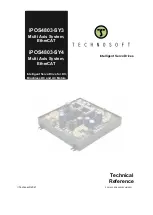
Customizing Your Application 8-3
MN766
Defi nition of “I” (Integral Gain)
Integral Gain (like Proportional Gain) is amplifi cation of the process error signal, but is time dependent. If a steady state
error exists for long periods of time, it is known as an offset. Integral gain compensates for this long term error or offset.
Generally speaking, if you were to use only proportional control in a process, the control output would never get the
controlled variable exactly equal to the input command. You would always have some small amount of error. This is often
called offset. The Integral term senses this long term offset, and corrects the control output to reduce the effect of offset.
Integral Gain is mathematically defi ned as:
A
out
K
i
t
Where:
A
out
= Controller output
K
i
= Integral gain
= Integrator symbol
= Process error signal = (setpoint - feedback)
= Change in time
This formula states that a given control output (A
out
) is equal to integral gain ( K
i
), multiplied by
the integral ( ) of the error ( ), multiplied by the change (
) in time ( t ). Simply, an Integrator loop
is used and error is accumulated over time (or integrated), and integral gain is used to reduce
long term error. Figure 8-3 shows this process.
t
H
H
H
Figure 8-3 Block Diagram of the I Element
Summing Junction
(error detector)
Input
Command
Error
Signal
Output
Power Input
Control
Measuring
Means
Load Disturbance
Controlled
Variable
Controlled Variable
Feedback
Motor
Feedback
Input
A
out
K
i
t
H
H
Содержание VS1SD
Страница 1: ...05 13 Installation Operating Manual MN766 VS1SD AC Servo Control...
Страница 12: ...2 2 General Information MN766...
Страница 16: ...3 4 Installing the Drive MN766...
Страница 108: ...7 34 Parameter Descriptions MN766...
Страница 114: ...8 6 Customizing Your Application MN766...
Страница 128: ...9 14 Troubleshooting MN766...
Страница 154: ...12 12 Monitor and RTC Description MN766...
Страница 188: ...E 2 Remote Keypad Mounting Template MN766...
















































